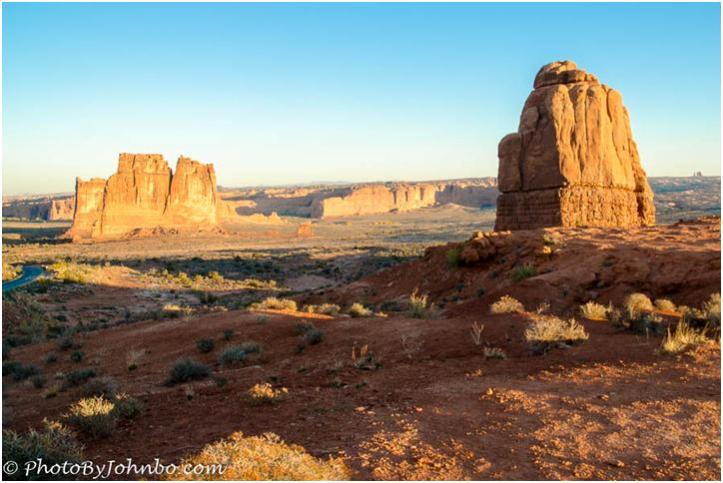
Sunrise in the Park
In the Utah high desert, smack dab in the middle of the “Colorado Plateau“, lays two national parks, Canyonlands and Arches. Only a few minutes’ drive from the town of Moab Utah, these two national parks attract vacationers all year round. On our annual trek between Fargo and Phoenix, Lynn and I stayed overnight at Moab and spent a couple of days exploring the two parks.
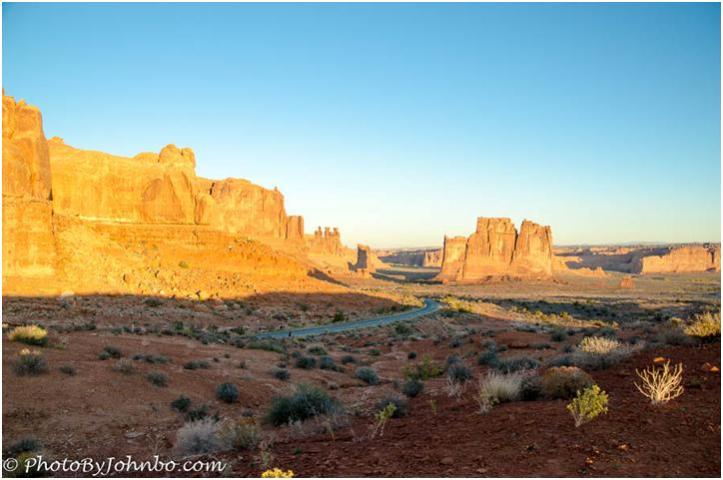
The single scenic road in the park meanders around giant sandstone formations
The weather was sunny and warm, but early in the morning in late October, the hoodies we brought along were welcome wear until the sun started warming the air for the day. We started our morning at the La Sal Mountains Viewpoint, along with a small group of people, cameras and tripods at the ready; awaiting sunrise and the golden hour.
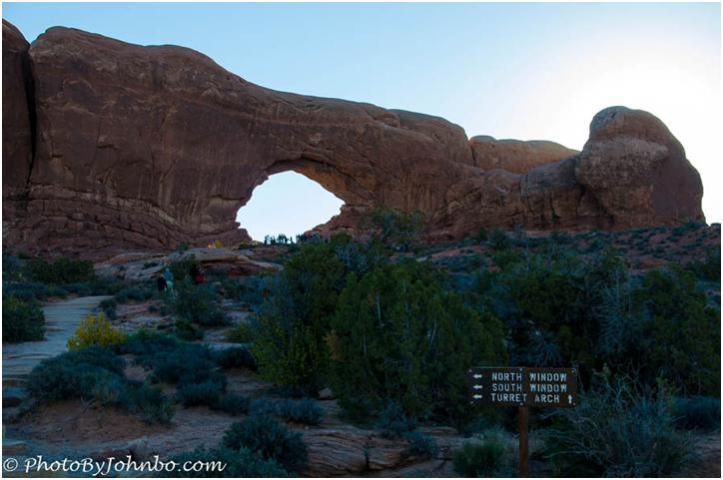
South Window is one of two arches in the same formation. The size of the arch can be gauged by the height of the people standing underneath.
Arches Park distinguishes itself featuring over 2000 documented natural stone arches. In addition to the arches, there are many other natural sandstone sculptures created by millions of years of wind and water erosion. Though the Colorado Plateau is a desert, this area gets more precipitation than other deserts areas, averaging 9 inches per year. The falling rain erodes the sandstone and in the winter, ice forms in cracks, expanding them, and eventually weakening and breaking off a section of the relatively soft rock.
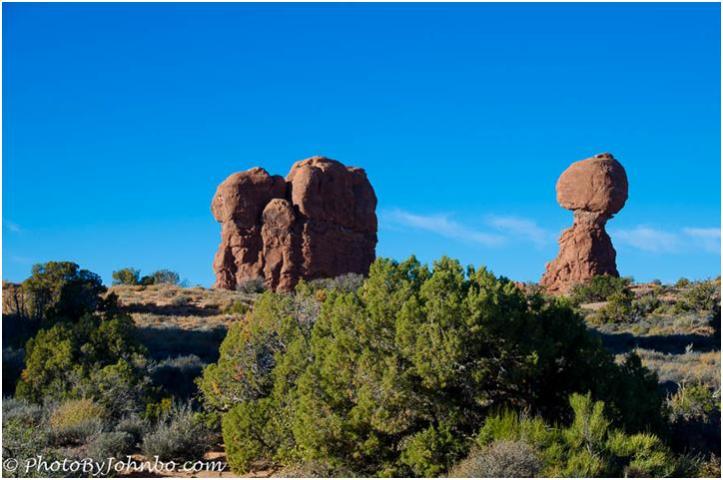
A large rock balances on a sandstone pedestal
A single road meanders through the park with “detours” to take visitors to view specific arches or other landmarks. Once in the parking area, you can expect to do some walking to reach the featured elements in that area. Some of those walks could more correctly be called hikes, and the feature could be a mile or more from where the car is parked. Signs at the trailheads are well marked and you can choose to make the hike or not, secure in the knowledge of the length of the hike. The Arches website has a list of hiking trails. Many of the popular attractions are at the end of easy hikes. One of the longer hikes is to Delicate Arch, but there are shorter hikes to viewpoints that are some distance from the arch. One of those hikes is handicap accessible, only 100 yards (91 meters); and the other, a climbing half-mile (0.8 km), led us to the viewpoint from where I took the photo below.

From a distance, Delicate Arch looks to be quite small. If you look closely to the right of the base, you’ll see a person wearing red and blue clothing.
Late fall is a good time to visit the park. In the summer, high temperatures and summer vacationers make the park more difficult to negotiate. As it turned out, there were very few people visiting each site we viewed when we got there. There was a tour bus at the South Window when we arrived and the busload of people was just finishing their stay. As we walked the short distance to the arch itself, the people on the bus tour were just leaving. As we visited each site, the tour bus was either just leaving as we arrived or just arriving as we were getting ready to leave. For once, our timing was impeccable.
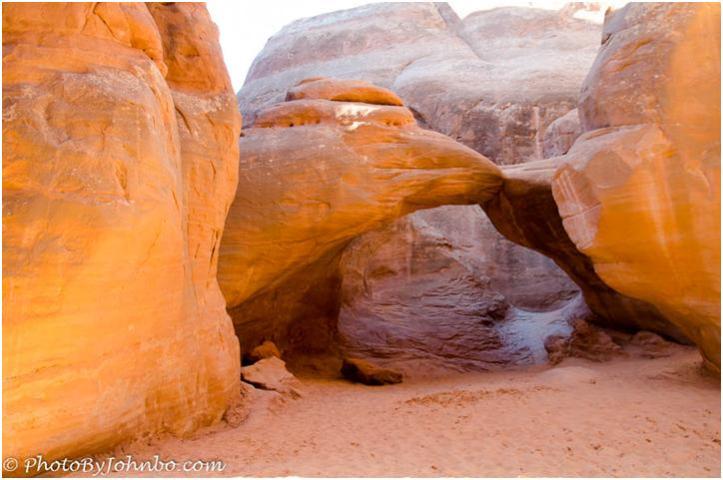
Hidden inside a sandstone canyon, Sand Dune Arch is and easy 0.4 miles (0.6 km) round trip from the parking area
The parking area near Sand Dune Arch is a trailhead for several separate paths to different features. We chose the shorter trail to Sand Dune Arch and were rewarded with a cool, shady view of the arch. Expect to get sand in your shoes if you aren’t wearing high top hiking boots. The walk through the area near the arch reminded me of a walk on a sandy beach.
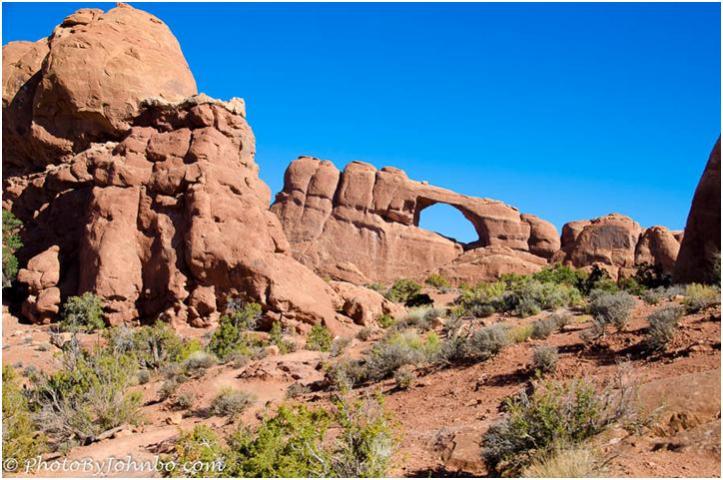
Skyline Arch can be viewed from many places in the park
Skyline Arch is an easy hike from the parking area, though the going gets tough if you wish to stand underneath the arch. This arch opening was much smaller until 1940 when a large part of the arch support broke away. The size of the opening became twice as large. Though the arches appear to be permanent, wind and water erosion is a constant threat. There are many examples of former arches in the park. Eventually, each arch will fail as erosion takes its toll.
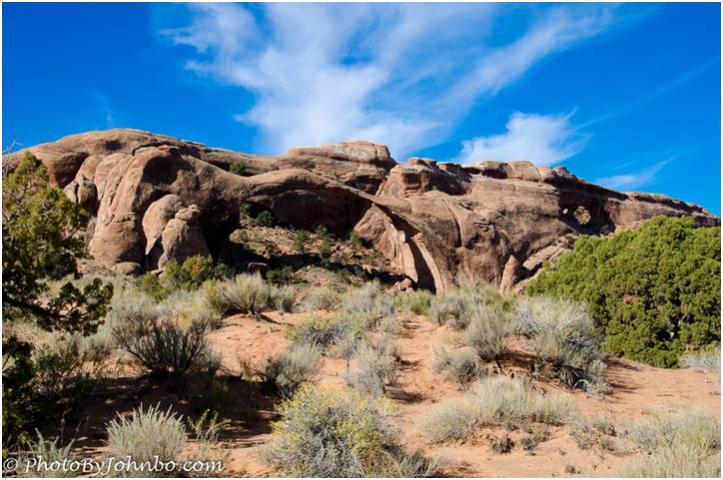
Landscape Arch is one of the first of several arches found along the trails in Devil’s Garden
At the end of the scenic drive through the park is the Devil’s Garden Trailhead. The trail is the longest in the park and winds past many iconic arches. The 7.2 mile (11.5 km) round trip will take three to five hours, and the narrow ledges and slick rock surfaces lead to a recommendation that the trail be avoided in wet or snowy weather. If you choose to walk this trail, bring plenty of water. You will be rewarded with some beautiful natural architecture. One of the largest arches in the park is Landscape Arch which spans 305 feet across the base.
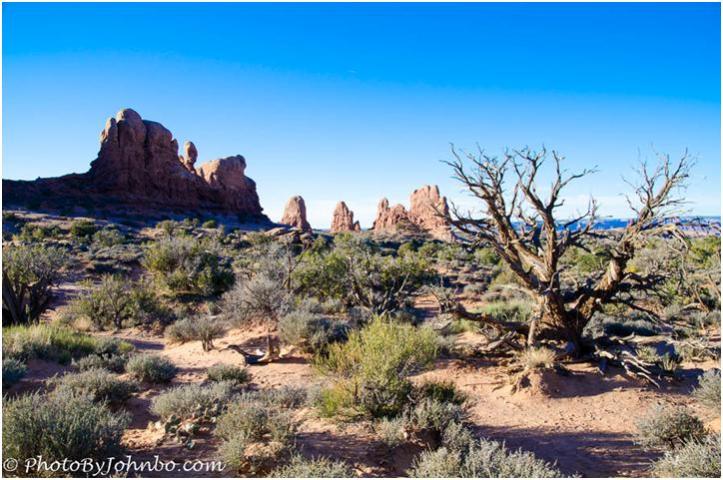
The high desert contains a wide variety of desert-adapted vegetation
The National Park Service Arches webpage contains a wealth of information about visiting the park. Start your trip there and plan accordingly. The desert can be an unforgiving place. Bring plenty of water. A good pair of walking shoes is a prerequisite. Hiking boots are recommended for the more advanced trails. This park is not best viewed from inside your car window. You must get out and walk to see much of the hidden beauty that has endured over the centuries.
John Steiner

These photos are amazing John! I’m so glad I stumbled upon your blog, it’s fantastic! Keep up the good work! 🙂
Thanks, very much for your kind comments! I will look forward to exploring your site as well. One of the great things about blogging is finding new blogs to follow.
Amazing pictures John! 😀 I’ve always wanted to visit Utah
It was our first trip to Utah, Salim. We are going back. We have three more parks to see.
wow you’ve already got some great pictures there. Im looking forward to see more 😀